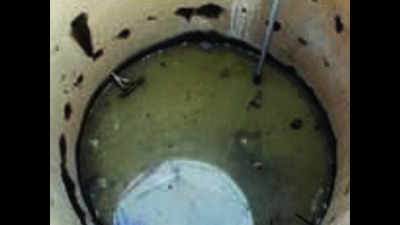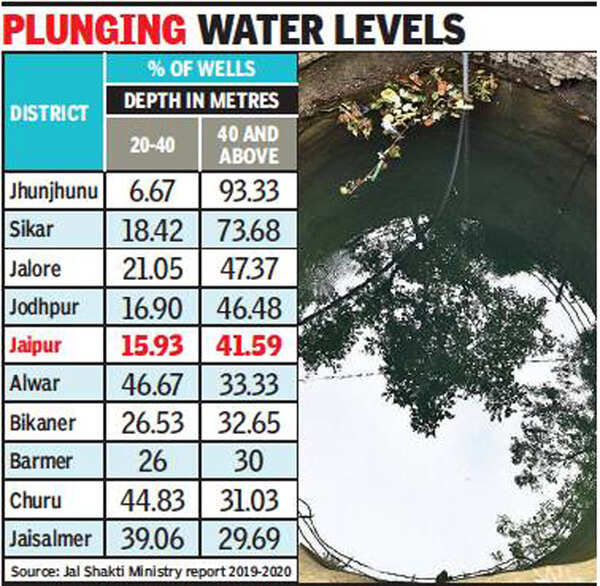- News
- City News
- jaipur News
- Water in 20% wells of Rajasthan unsuitable for drinking
Trending
This story is from June 5, 2021
Water in 20% wells of Rajasthan unsuitable for drinking
Groundwater table in every fifth well (20%) in the state has gone below the alarming level of 40 metres, making it largely unfit for drinking. The water below 40 metres contains sulphur, chlorine and fluoride more than the permissible limit, posing health hazards when consumed constantly.

Representative image
JAIPUR: Groundwater table in every fifth well (20%) in the state has gone below the alarming level of 40 metres, making it largely unfit for drinking. The water below 40 metres contains sulphur, chlorine and fluoride more than the permissible limit, posing health hazards when consumed constantly.
Ministry of Jal Shakti’s latest groundwater report on Rajasthan 2019-2020 says that five districts had more than 40% of their wells recording water level below 40 metres in January 2020.The figure comes in stark contrast with the fact that annual rainfall in the state increased by 29.5% in 2019 from 2010-2018 (average).

The situation doesn’t appear better even this year as rainfall in 2020 was slightly higher and intense, but took place over a less duration.
The health hazards of a lower water table are many. However, no action has been taken on the report due to the pandemic. “Every year, at least twice we conduct a quality check on the wells’ water and ones with high chemical content are banned from use, until their level touches the permissible limits,” said Narottam Sharma, CMHO Jaipur-1. He assured that once the staff gets some time from Covid duty, they will go for the quality check.
Jal Jeevan Mission scheme data says that barely 19% of rural households have piped water connections, leaving the vast majority to depend on other water sources, including wells for drinking and other purposes.
“Every eight out of 10 respondents I met during the research report were suffering from skeletal fluorosis in blocks Ahor, Jalore and Sanchore of Jalore district,” said Navneet Mishra, state programme officer, INREM, a sector partner of Jal Jeevan Mission scheme, while adding that he has suggested to the district administration to promote surface water storage structures under MGNREGA’s rehabilitation of water storage structure like in Karnataka and Gujarat.
Calling for the immediate action on wells with low water table, RK Goyal, principal scientist (Hydrology), Central Arid Zone Research Institute (CAZRI) said, “A deeper groundwater table comes with geogenic salts like fluoride, nitrate, calcium, magnesium and in some places, uranium as well. Its consumption is not clinically good for the human body,” said Goyal.
On the other hand, shallow water level less than 2 metres or below has been observed in some places in districts like Bundi, Kota, Pratapgarh, Banswara, Jhalawar, Baran, Dungarpur and Pali districts.
Ministry of Jal Shakti’s latest groundwater report on Rajasthan 2019-2020 says that five districts had more than 40% of their wells recording water level below 40 metres in January 2020.The figure comes in stark contrast with the fact that annual rainfall in the state increased by 29.5% in 2019 from 2010-2018 (average).

The situation doesn’t appear better even this year as rainfall in 2020 was slightly higher and intense, but took place over a less duration.
Jhunjhunu is leading, with 91% of the wells that had gone 40m and above in January 2020 (post monsoon) while in monsoon, the arid city received 32.81% more rain than the previous years. The report says that Jaipur alone had 41% of the wells with water table below 40 metres, despite receiving 744MM rain, which was 29.21% more than the average of the previous 8 years. Experts have said that wells are being overused and are thus not recharged even after sufficient rain.
The health hazards of a lower water table are many. However, no action has been taken on the report due to the pandemic. “Every year, at least twice we conduct a quality check on the wells’ water and ones with high chemical content are banned from use, until their level touches the permissible limits,” said Narottam Sharma, CMHO Jaipur-1. He assured that once the staff gets some time from Covid duty, they will go for the quality check.
Jal Jeevan Mission scheme data says that barely 19% of rural households have piped water connections, leaving the vast majority to depend on other water sources, including wells for drinking and other purposes.
“Every eight out of 10 respondents I met during the research report were suffering from skeletal fluorosis in blocks Ahor, Jalore and Sanchore of Jalore district,” said Navneet Mishra, state programme officer, INREM, a sector partner of Jal Jeevan Mission scheme, while adding that he has suggested to the district administration to promote surface water storage structures under MGNREGA’s rehabilitation of water storage structure like in Karnataka and Gujarat.
Calling for the immediate action on wells with low water table, RK Goyal, principal scientist (Hydrology), Central Arid Zone Research Institute (CAZRI) said, “A deeper groundwater table comes with geogenic salts like fluoride, nitrate, calcium, magnesium and in some places, uranium as well. Its consumption is not clinically good for the human body,” said Goyal.
On the other hand, shallow water level less than 2 metres or below has been observed in some places in districts like Bundi, Kota, Pratapgarh, Banswara, Jhalawar, Baran, Dungarpur and Pali districts.
End of Article
FOLLOW US ON SOCIAL MEDIA










